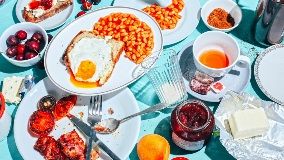
Eating healthy is important but certain foods can worsen anxiety. These foods can worsen anxiety. Here are the best ways to avoid them. Limit your intake. A food diary can be used to record the foods that you eat each day for a week. Once you have done this, you will be able identify foods that make you anxious and those that don't. As long as your diet is healthy, you will be fine.
Fried foods can be very unhealthy and can cause anxiety. Additionally, they are more difficult to digest due to their unhealthy cooking. Hydrogenated oil is used to fry most fried foods. It can be bad for your heart, and can also cause a rebound effect. Instead, eat more vegetables or fruits high in potassium and/or magnesium. Olive oil and avocado are great choices for cooking.
Junk food and fried foods are not good for your health. They can also cause excess gas and acid reflux, as they are difficult to digest. Even choking sensations may occur. To avoid these foods, eat plenty of green vegetables, including leafy vegetables and nuts. Additionally, you should avoid eating large quantities of sugar-laden meals. You should also try to reduce your alcohol intake.

You can reduce the amount of these foods by eating more lean protein. This is because protein helps keep you full and stable. Also, pizzas and hamburgers can have long-term negative effects on your health. They are high in sugar, sodium, fat, and calories. If you are unable to stop eating them then try eating more vegetables such as Mediterranean chickpea burgers or grilled vegetables. You can also limit your wine intake, which will only make your situation worse.
A few people are sensitive to alcohol. This can lead to anxiety attacks. Alcohol can also negatively impact brain serotonin levels. As a result, it can cause other negative effects, including increased heart rate and blood sugar level. It also affects the immune system, so avoid drinking alcohol. A good substitute for these beverages is whole grain breads and dried beans. They should be avoided at any cost.
Refined sugars such as white bread and pastries are high in sugar, which can lead to anxiety symptoms. Refined sweeteners can also cause mood swings. This can lead to anxiety. Luckily, many fruits and vegetables contain the necessary vitamins and minerals that are crucial to maintaining a healthy life. You can avoid foods that cause anxiety while still feeling well. It's also possible to eliminate other foods that cause anxiety.
Certain foods are better or worse for you than others. Anxiety has been linked to some of these foods. They may not have the same effect as high-fat foods, but they can cause anxiety. Saturated fats, such as those found in fried foods, can cause problems with the heart's ability of pumping blood. Some people feel better if they avoid processed sweeteners, while others feel worse if their bodies have more sugar.

High levels of refined carbohydrates should be avoided by people suffering from anxiety disorder. These foods are often loaded with added salt, high calories and unhealthy fats. Panic attacks can be triggered by a rapid and stressful rise in blood sugar. Avoid greasy food if anxiety strikes. Rather, stick with whole-grain products, such as brown rice, oats, and quinoa.
Certain foods can cause anxiety in people suffering from anxiety disorders. Alcohol can worsen anxiety symptoms. Research has shown that drinking alcohol can lead to anxiety disorders like depression. If you must drink alcohol, consider drinking non-alcoholic beer instead. If you have to drink, make sure it is a non-alcoholic option. If you do not want to consume alcohol, don't. You can still enjoy a glass of wine, beer or other alcohol if you have to.
FAQ
How often do I need to exercise?
For a healthy lifestyle, exercise is vital. There is no set time limit for exercising. The key is finding something you enjoy and stick with it.
Three times a week, you should be aiming to complete 20-30 mins of moderate intensity activity. Moderate intensity is when you still have to breathe hard after the workout. This type is good for burning around 300 calories.
For those who prefer to walk, you can go for 10-minute walks four times a week. Walking is low impact and easy on your joints.
If you'd rather run, try jogging for 15 minutes three times a week. Running is an excellent way to lose weight and tone your muscles.
Start slowly if you aren't used to doing exercise. Begin with 5 minutes of cardio every other day. Gradually increase the time you do cardio until your goal is reached.
What are 5 ways to live a healthy lifestyle?
Healthy lifestyles include eating right, exercise regularly, getting enough rest, managing stress, having fun, and eating healthy. Good eating habits include avoiding processed foods, sugar, unhealthy fats, and avoiding junk food. Exercise strengthens your muscles and helps you lose calories. Sleeping enough can improve memory and concentration. Stress management reduces anxiety, depression and other symptoms. Fun keeps us vibrant and young.
What is the difference between a virus and a bacterium?
A virus is a microscopic organism that cannot reproduce outside its host cell. A bacterium, a single-celled organism, reproduces by splitting into two. Viruses measure only 20 nanometers in diameter, but bacteria is up to 1 millimeter in size.
Viruses can be spread by contact with bodily fluids containing infected substances, such as saliva, urine and semen. Bacteria is usually spread directly from surfaces or objects contaminated with bacteria.
Viruses may enter the body through cuts, scrapes. bites, or any other break in the skin. They may also enter through the nose, mouth, eyes, ears, vagina, rectum , or anus.
Bacteria can be introduced to our bodies by cuts, scrapes or burns. They can also get into our bodies via food, water or soil.
Both viruses and bacteria can cause illness. Viruses can not multiply within the host. So they only cause illnesses when they infect living cells.
Bacteria can spread within the host and cause illness. They can infiltrate other parts of the body. To kill them, we must use antibiotics.
How can I get enough vitamins?
You can get most of the daily nutrients you need through your diet. Supplements can be helpful if you are lacking in any one vitamin. You can take a multivitamin supplement that contains all the vitamins you need. You can also buy individual vitamins in your local drugstore.
Talk to your doctor if there are any concerns about getting enough nutrients. Some examples of rich sources of vitamins E and K include dark green leafy vegetables, such as spinach.
Ask your doctor to help you determine the right amount of vitamin. Your medical history and current health will help you determine the best dosage.
Statistics
- WHO recommends consuming less than 5% of total energy intake for additional health benefits. (who.int)
- According to the Physical Activity Guidelines for Americans, we should strive for at least 150 minutes of moderate intensity activity each week (54Trusted Source Smoking, harmful use of drugs, and alcohol abuse can all seriously negatively affect your health. (healthline.com)
- WHO recommends reducing saturated fats to less than 10% of total energy intake; reducing trans-fats to less than 1% of total energy intake; and replacing both saturated fats and trans-fats to unsaturated fats. (who.int)
- nutrients.[17]X Research sourceWhole grains to try include: 100% whole wheat pasta and bread, brown rice, whole grain oats, farro, millet, quinoa, and barley. (wikihow.com)
External Links
How To
What does "vitamin" actually mean?
Vitamins are organic compounds that can be found in foods. Vitamins aid us in absorbing nutrients from the food we eat. The body cannot make vitamins; therefore, they must be obtained from food.
There are two types of vitamins: water soluble and fat soluble. Water-soluble vitamins dissolve in water easily. Vitamin C,B1(thiamine), B2 (2riboflavin), and B3 (3niacin), as well as vitamin C,B1, B2 (riboflavin), and B3 (niacin), vitamin B6 (pyridoxine), vitamin folic acid (biotin), pantothenic, and choline are examples. The liver and fatty tissues are home to fat-soluble vitamins. Some examples include vitamin D and E, K, A and beta carotene.
Vitamins are classified based on their biological activity. There are eight major vitamin groups:
-
A - vital for healthy growth.
-
C – essential for proper nerve function.
-
D - Essential for healthy teeth and bones.
-
E - needed for good vision and reproduction.
-
K - Required for healthy nerves and muscles.
-
P - essential for strong bones, teeth and tendons
-
Q - aids digestion, absorption and absorption iron
-
R is required for the production of red blood cells.
The recommended daily intake (RDA), of vitamins varies with age, gender and physical condition. The U.S. Food and Drug Administration, (FDA), sets the RDA value.
For adults aged 19 and older, the RDA for vitamin B is 400 micrograms daily. Because it is essential for the development of the fetus, pregnant women should consume 600 micrograms per daily. Children ages 1-8 require 900 micrograms per day. Children under 1 year old require 700 micrograms daily, while infants over one year old need 500 micrograms every day. This decreases between 9 and 12 months.
Children ages 1-18years who are obese need 800 micrograms per day while those who are overweight need 1000 micrograms per day and children who are underweight need 1200 micrograms per day to meet their nutritional needs.
2200 mg of vitamin A per day is required for children aged 4-8 who have been diagnosed by anemia.
2000 micrograms are required daily for good health in adults over 50. Women who are pregnant or breastfeeding need 3000 micrograms per day due to increased nutrient requirements.
Adults over 70 need 1500 micrograms daily, as they lose 10% of their muscle every ten years.
Women who are pregnant and lactating need more nutrients than the RDA. Pregnant woman need 4000 micrograms daily in pregnancy, and 2500 per day after childbirth. Breastfeeding moms need 5000 micrograms each day when breastmilk production occurs.